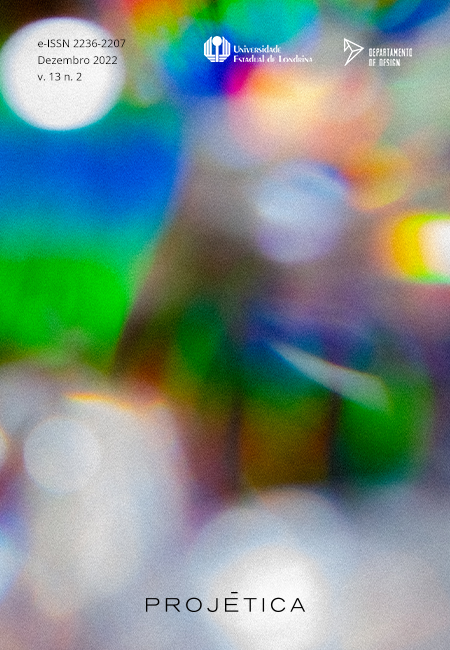Relations between multisensory languages in the design of spatiality
DOI:
https://doi.org/10.5433/2236-2207.2022v13n2p254Palavras-chave:
Design of Spatiality, Surface Design, Immersion, Well-beingResumo
The current speed of information may bring anxiety and stress symptoms to people's lives. A space with multisensory elements where individuals feel immersed in welcome feelings may reduce these symptoms. Our objective is to list multisensory aspects for Surface Design to structure spatiality with immersive and relaxing attributes. We made a literature review to analyse the sensory elements that authors consider important and identified relevant multisensory aspects. We expect to contribute to projects that aim to promote well-being.
Downloads
Referências
ABREU, A. A. Happy Place: Como Criar Locais Felizes. Lisboa: [s.n.].
AGUIAR, E. C.; FARIAS, S. A. DE. Estímulos Sensoriais e seus Significados para o Consumidor: Investiganto uma Atmosfera de Serviço Centrado na Experiência. Revista Brasileira de Marketing, v. 13, n. 5, p. 65-77, 2014. DOI: https://doi.org/10.5585/remark.v13i5.2494
ALCÁNTARA-ALCOVER, E.; ARTACHO-RAMÍREZ, M.; ZAMORA-ÁLVAREZ, T.; MARTINEZ, N. Exploratory Study of the Influence of the Sensory Channel in Perception of Environments. Journal of Sensory Studies, v. 29, p. 258-271, 2014. DOI: https://doi.org/10.1111/joss.12099
BROWN, E.; CAIRNS, P. A Grounded Investigation of Game Immersion. Londres: [s.n.].
BURNARD, M. D.; KUTNAR, A. Wood and human stress in the built indoor environment : a review. Wood Science and Technology, v. 49, n. 5, p. 969-986, 2015. DOI: https://doi.org/10.1007/s00226-015-0747-3
CAETANO, U. F. L.; ROLDO, L.; GRANSOTTO, L. R.; KURBAN, A. E. A. Design para o bem-estar : uma abordagem orientada para o pensamento sustentável e para sustentabilidade. Estudos em Design, v. 23, n. 2, p. 150-166, 2015.
CASACCIA, R. B. Você sabe o que é Design Biofílico e como influencia na nossa saúde e bem-estar? Disponível em: <https://ecotelhado.com/voce-sabe-o-que-e-design-biofilico-e-como-influencia-na-nossa-saude-e-bem-estar/>. Acesso em: 27 jun. 2019.
CLEMENTS-CROOME, D.; PALLARIS, K.; TURNER, B. Flourishing Workplaces : A Multisensory Approach to Design and POE. Intelligent, n. January, 2019. DOI: https://doi.org/10.1080/17508975.2019.1569491
COSTA, H.; SANTOS, A. DOS. Design para serviços e a estética sonora no servicescape: influência na experiência estética dos usuários. Projética, v. 10, n. 1, p. 77-94, 2019. DOI: https://doi.org/10.5433/2236-2207.2019v10n1p77
ENGINEER, A.; STERNBERG, E. M.; NAJAFI, B. Designing Interiors to Mitigate Physical and Cognitive Deficits Related to Aging and to Promote Longevity in Older Adults : A Review. Gerontology, v. 85721, p. 11, 2018. DOI: https://doi.org/10.1159/000491488
FERNANDES, I. P.; MOURA, N. C. S.; COSTA, A.A. Impressões qualitativas em espaços urbanos noturnos por meio de ambientes virtuais imersivos. Revista Brasileira de Gestão Irbana, v. 10, n. 1, p. 95-110, 2018. DOI: https://doi.org/10.1590/2175-3369.010.001.ao08
GENTNER, A.; BOUCHARD, C.; ESQUIVEL, D.; FAVART, C. Mapping a Multi-sensory Identity Territory at the Early Design Stage. International Journal od Affective Engineering, v. 12, n. 2, p. 191-200, 2012. DOI: https://doi.org/10.5057/ijae.12.191
JAKOB, A.; COLLIER, L. Sensory Design for Dementia Care - The Benefits of Textiles. Journal of Textile Design Research and Practice, v. 5, n. 2, p. 232-250, 2018. DOI: https://doi.org/10.1080/20511787.2018.1449078
KEELING, T.; CLEMENTS-CROOME, D.; LUCK, R.; POINTER, P. A review of how sensory design can influence wellbeing and productivityCIBSE ASHRAE Technical Symposium, 2012.
KERR, C. S. A review of the evidence on the importance of sensory design for intelligent buildings. Intelligent Buildings International, v. 5, n. 4, p. 204-212, 2013. DOI: https://doi.org/10.1080/17508975.2013.808982
LEE, S.; ALZOUBI, H. H.; KIM, S. The Effect of Interior Design Elements and Lighting Layouts on Prospective Occupants ' Perceptions of Amenity and Efficiency in Living Rooms. Sustainability, v. 9, p. 30, 2017. DOI: https://doi.org/10.3390/su9071119
MCGANN, S. De(sign) in patient space : User-creativity in hospital settings. The Journal of Health Design, p. 33-38, 2017. DOI: https://doi.org/10.21853/JHD.2017.32
PLATT, L. S.; BOSCH, S. J.; KIM, D. Toward a Framework for Designing Person-Centered Mental Health Interiors for Veterans. Journal of Interior Design, v. 42, n. 2017, p. 27-48, 2017. DOI: https://doi.org/10.1111/joid.12095
TONETTO, L. M. A perspectiva cognitiva no design para emoção : análise de concerns em projetos para a experiência. Strategic Design Research Journal, v. 5, n. 3, 2012. DOI: https://doi.org/10.4013/sdrj.2012.53.01
ULUSOY, B.; OLGUNTURK, N. Understanding Responses to Materials and Colors in Interiors. Wiley Periodicals, p. 1-12, 2016.
Downloads
Publicado
Como Citar
Edição
Seção
Licença
Copyright (c) 2022 Projetica

Este trabalho está licenciado sob uma licença Creative Commons Attribution 4.0 International License.
Projética está licenciada sob a Creative Commons Attribution CC-BY 4.0 International. Os autores detém os direitos autorais e concedem à revista o direito de exclusividade de primeira publicação.
Os autores dos trabalhos aprovados autorizam Projética a, após a publicação, ceder seu conteúdo para reprodução em indexadores de conteúdo, bibliotecas virtuais e similares.
Os autores assumem que os textos submetidos à publicação são de sua criação original, responsabilizando-se inteiramente por seu conteúdo em caso de eventual impugnação por parte de terceiros. As opiniões emitidas pelos autores dos artigos são de sua exclusiva responsabilidade.
A revista se reserva o direito de efetuar, nos originais, alterações de ordem normativa, ortográfica e gramatical, com vistas a manter o padrão culto da língua e a credibilidade do veículo. Respeitará, no entanto, o estilo de escrever dos autores. Alterações, correções ou sugestões de ordem conceitual serão encaminhadas aos autores, quando necessário. Nesses casos, os artigos, depois de adequados, deverão ser submetidos a nova apreciação. As provas finais não serão encaminhadas aos autores.












